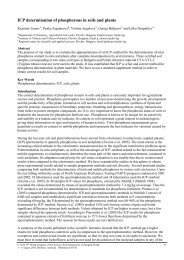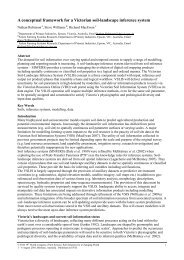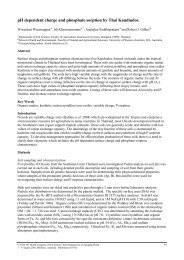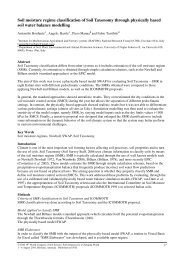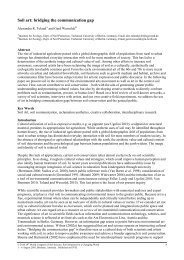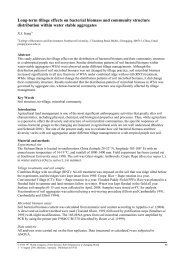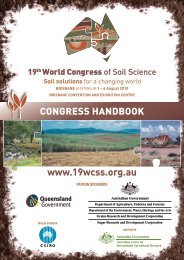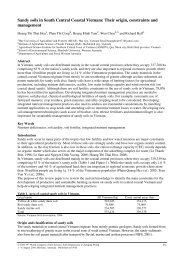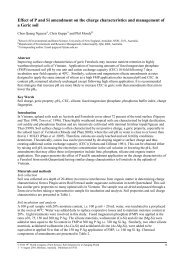Costantini Edoardo A. - International Union of Soil Sciences
Costantini Edoardo A. - International Union of Soil Sciences
Costantini Edoardo A. - International Union of Soil Sciences
You also want an ePaper? Increase the reach of your titles
YUMPU automatically turns print PDFs into web optimized ePapers that Google loves.
A geodatabase <strong>of</strong> the soil cultural heritage <strong>of</strong> Italy<br />
<strong>Edoardo</strong> AC <strong>Costantini</strong> A and Giovanni L’Abate B<br />
A CRA-ABP Research centre for agrobiology and pedology, Florence, Italy, Email edoardo.costantini@entecra.it<br />
B CRA-ABP Research centre for agrobiology and pedology, Florence, Italy, Email labate@issds.it<br />
Abstract<br />
<strong>Soil</strong>s can possess heritage characteristics and can be classified according to their "cultural value". The<br />
methodology used to evaluate and group pedosites <strong>of</strong> Italy, and the s<strong>of</strong>tware developed to collect such<br />
information and create a specific geodatabase, are presented in this paper as an example for use in other<br />
countries. A map and a geodatabase storing 726 pedosites <strong>of</strong> Italy was created. <strong>Soil</strong> pr<strong>of</strong>iles as cultural<br />
heritage were: i) paleosols, ii) soils from the archaeological and paleontological sites, iii) soil displaying<br />
natural or anthropic processes and benchmarks <strong>of</strong> classifications. Pedosites as soilscapes were: i) cultural<br />
landscapes; ii) soilscapes determining the amenity <strong>of</strong> a panorama; iii) soilscapes in fragile environmental<br />
balance; iv) soilscapes that contribute to the maintenance <strong>of</strong> particular ecosystems. The criteria for the<br />
evaluation <strong>of</strong> pedosites and the suggestions for their protection were indicated as following: i) area and ii)<br />
type <strong>of</strong> scientific interest, iii) state <strong>of</strong> conservation, iv) type and v) intensity <strong>of</strong> risk, vi) level <strong>of</strong> knowledge,<br />
vii) geological age, viii) protection and ix) proposed protection, x) accessibility, xi) visibility, xii) exposure,<br />
xiii) observability. The geodatabase can be used at different scales, from the national to the local level.<br />
Key Words<br />
Pedosite, geosite, paleosol, land planning, soil awareness, Mediterranean<br />
Introduction<br />
The geosite concept (that is a geological site having scientific, historic and cultural heritage interest) has<br />
been internationally acknowledged (Todorov and Wimbledon 2004). The Council <strong>of</strong> Europe committee <strong>of</strong><br />
ministers, in the Recommendation Rec (2004) on conservation <strong>of</strong> the geological heritage and areas <strong>of</strong> special<br />
geological interest (Adopted by the Committee <strong>of</strong> Ministers on 5 May 2004 at the 883rd meeting <strong>of</strong> the<br />
Ministers' Deputies) recommends that governments <strong>of</strong> member states identify in their territories areas <strong>of</strong><br />
special geological interest, the preservation and management <strong>of</strong> which may contribute to the protection and<br />
enrichment <strong>of</strong> national and European geological heritage. At the same time, it was suggested to develop<br />
national strategies and guidelines for the protection and management <strong>of</strong> areas <strong>of</strong> special geological interest,<br />
embodying the principles <strong>of</strong> inventory development, site classification, database development, site condition<br />
monitoring and tourist and visitor management, to ensure sustainable use <strong>of</strong> areas <strong>of</strong> geological interest<br />
through appropriate management. As a role, databases <strong>of</strong> geosites take into account a few <strong>of</strong> the most<br />
important paleosols, but other kinds <strong>of</strong> soils displaying cultural heritage still lack <strong>of</strong> a specific interest. More<br />
recently, there has been a trend towards the evaluation <strong>of</strong> some hitherto inadequately recognised soil<br />
functions (such as its role as guardian <strong>of</strong> biodiversity, safe keeper <strong>of</strong> many archeological, paleotechnological<br />
and paleontological treasures) <strong>of</strong> values which are not immediately or easily quantified in monetary terms<br />
(Yaalon and Arnold 2000). The doors have thus been opened to the idea <strong>of</strong> taking into account a whole series<br />
<strong>of</strong>, broadly speaking, cultural aspects linked to the knowledge accumulated on a pedological site. This<br />
information may be connected to that site or be functionally dependent upon it, to the extent that the soil can<br />
be considered to all effects and purposes - including legal aspects – as having a “cultural heritage”. While it<br />
is true that all soils “narrate” the events which have taken place on a territory, and therefore possess a certain<br />
cultural value, some can nevertheless claim superiority over the others, either because <strong>of</strong> the quantity <strong>of</strong><br />
information preserved or else because <strong>of</strong> the quality or importance <strong>of</strong> this data.<br />
Although there is still a lack <strong>of</strong> widespread systematic work in Italy, an increasing number <strong>of</strong> pedologists<br />
have substantially amplified their sensibility towards the cultural values <strong>of</strong> the soil. Over the years, some<br />
basic concepts have been developed, which permitted to consider new categories <strong>of</strong> pedosites, besides<br />
paleosols (<strong>Costantini</strong> 1999). Work has been carried out at both a local scale (Arnoldus-Huyzenveld and<br />
Gisotti 1999) and a regional scale (Brenna and Rasio 1999; <strong>Costantini</strong> et al. 2007). The idea <strong>of</strong> collecting<br />
pedosites <strong>of</strong> Italy was born during the second international symposium on the conservation <strong>of</strong> our cultural<br />
heritage, held in Rome in 1996. A pedosite was defined there as a georeferenced soil having cultural<br />
heritage, that is, a soil exposure or a soilscape where an extraordinary cultural interest has been recognized<br />
(<strong>Costantini</strong> 1999). In fact, a pedosite can take the form <strong>of</strong> an exposure or a trait <strong>of</strong> land, as soil possesses<br />
© 2010 19 th World Congress <strong>of</strong> <strong>Soil</strong> Science, <strong>Soil</strong> Solutions for a Changing World<br />
1 – 6 August 2010, Brisbane, Australia. Published on DVD.<br />
1
oth a vertical dimension – the pr<strong>of</strong>ile – and a horizontal dimension – the soilscape. The actual collection <strong>of</strong><br />
the pedosites started in the year 1999, as a side-activity <strong>of</strong> the national project dealing with the creation <strong>of</strong> a<br />
soil database <strong>of</strong> Italy and it is still in progress. The purpose <strong>of</strong> this work is to describe the methodology used<br />
to evaluate and group pedosites <strong>of</strong> Italy, and the s<strong>of</strong>tware developed to collect such information and create a<br />
specific geodatabase. In addition, the map <strong>of</strong> pedosites having national interest is reported.<br />
Methods<br />
The collaboration <strong>of</strong> many soil surveyors made the census possible. The information was seldom published,<br />
so it was necessary to interview the surveyor to collect it. Paleosols are exceptions, as many published<br />
studies could be considered, giving the possibility to better assess the relative scientific relevance <strong>of</strong> the<br />
pedosites. The pedologists who signalled the pedosites also furnished an empirical evaluation <strong>of</strong> their value,<br />
which was maintained as either local or regional area <strong>of</strong> interest. The classification <strong>of</strong> national or<br />
international pedosites was obtained with a uniform and original method.<br />
<strong>Soil</strong> pr<strong>of</strong>iles as pedosites<br />
<strong>Soil</strong> pr<strong>of</strong>iles as pedosites were the followings:<br />
i) Paleosols. Dated paleosols were considered particularly important, in that they can be used as stratigraphic<br />
markers and thus give more accuracy to the mapping <strong>of</strong> Quaternary formations. ii) <strong>Soil</strong>s from the<br />
archeological and paleontological sites. Pedosites <strong>of</strong> this category were only signalled when there was a clear<br />
recognition <strong>of</strong> the input provided by pedological studies in understanding the environmental processes which<br />
exerted an influence on ancient human settlements. iii) <strong>Soil</strong>s displaying at best natural and anthropic<br />
processes. Included in this group were the soils representing the main taxonomic units <strong>of</strong> the pedological<br />
classification, as well as the benchmark pr<strong>of</strong>iles <strong>of</strong> the main types <strong>of</strong> Italian soil.<br />
<strong>Soil</strong>scapes as pedosites<br />
<strong>Soil</strong>scapes declared as pedosites included:<br />
i) <strong>Soil</strong>s characterising a precise and important cultural landscape. The characteristics <strong>of</strong> the soil, its fertility<br />
and the agricultural landscape are factors which interact to form a characteristic “whole” or “unit”. ii) <strong>Soil</strong>s<br />
as panoramic beauty. These soils were acknowledged as contributing to the amenity and attractiveness <strong>of</strong> a<br />
landscape through their colour. iii) <strong>Soil</strong>s occurring in fragile environmental balance. iv) <strong>Soil</strong>s that support<br />
fragile ecosystems, like soils related to specific biotopes, in particular, some wetlands.<br />
Criteria for the evaluation <strong>of</strong> pedosites<br />
The classification <strong>of</strong> the pedosite value followed the specifications <strong>of</strong> the pedosite category.<br />
i) Level <strong>of</strong> interest (importance). The pedosites were classified <strong>of</strong> international, national, regional and local<br />
interest. ii) Types <strong>of</strong> scientific interest. Every pedosite was specified up to five types <strong>of</strong> interest. iii) State <strong>of</strong><br />
conservation. iv) Type <strong>of</strong> risk to lose natural/cultural heritage. v) Degree <strong>of</strong> risk to lose natural/cultural<br />
heritage. vi) Level <strong>of</strong> knowledge. The cultural value <strong>of</strong> a pedosite took into account the quantity and quality<br />
<strong>of</strong> the studies carried out on it. vii) Geological age. In this section the estimated age <strong>of</strong> the pedosite was<br />
reported, when possible and relevant. Eight classes were considered: Holocene, late, middle and early<br />
Pleistocene, Pliocene, Miocene, ages prior to these. viii) Protection. A pedosite belonging to a protected area<br />
was considered particularly worthy, not only because its conservation was deemed easier, but above all<br />
because its potential scientific, didactic, and touristic values were enhanced. ix) Proposed protection, or<br />
“measures”. x) Accessibility. xi) Visibility. xii) Exposure. xiii) Observability.<br />
The geodatabase<br />
An original geodatabase was created to store the pedosites. Since pedosites could be either soil pr<strong>of</strong>iles or<br />
soilscapes, every record <strong>of</strong> the new geodatabase referred to a point or an areal location (polygon). Therefore,<br />
every soil pr<strong>of</strong>ile was located with its point coordinates, while a soilscape was formed by one or more<br />
polygons. The database created runs with the s<strong>of</strong>tware Access® (versions 2000 and followings) and its tables<br />
were structured so as to be easily imported into national and international Geosites databases. Data can be<br />
entered by means <strong>of</strong> a form with combo box menus. The s<strong>of</strong>tware permits to store photographs and to print<br />
the form <strong>of</strong> the pedosite. The main tables are: “t_pedosites”, “bibliography” and “<strong>Soil</strong>_region”. The fields <strong>of</strong><br />
the table t_pedosites are those described in the paragraphs above, plus the identification codes, the local<br />
name <strong>of</strong> the soil, site indications (nation, region, province, place), pedosite surveyor, soil classification,<br />
© 2010 19 th World Congress <strong>of</strong> <strong>Soil</strong> Science, <strong>Soil</strong> Solutions for a Changing World<br />
1 – 6 August 2010, Brisbane, Australia. Published on DVD.<br />
2
Figure 1. Map <strong>of</strong> the national pedosites and soil regions <strong>of</strong> Italy.<br />
according to either <strong>Soil</strong> Taxonomy (<strong>Soil</strong> Survey Staff 1999) or World Reference Base for <strong>Soil</strong> Resources<br />
(IUSS-ISRIC-FAO-ISSDS 1998), geological formation, and a note with a free wide description <strong>of</strong> the<br />
pedosite. The fields <strong>of</strong> the table bibliography are those which can be retrieved from a standard bibliographic<br />
citation. The fields <strong>of</strong> the table “<strong>Soil</strong>_region” are the same <strong>of</strong> the European database (Finke et al. 1998). The<br />
geographic information <strong>of</strong> pedosites instead is stored in the tables: “l_pedosites_gdb” and<br />
“p_pedosites_gdb”. All the geographic information can be read through the s<strong>of</strong>tware ArcGIS (versions 8.x<br />
and followings).<br />
Results<br />
The geodatabase stores at present 726 pedosites. The majority <strong>of</strong> them are paleosols (598) followed by<br />
pedosites showing natural or anthropic processes (benchmarks, 58), and cultural landscapes (36 pedosites).<br />
There are some 107 pedosites with national degree <strong>of</strong> interest, 228 regional, and 391 with local interest. The<br />
few pedosites acknowledged at international level were joined to national ones. The conservation state <strong>of</strong><br />
pedosites is good for 72%. There are some 79 pedosite at risk <strong>of</strong> loss <strong>of</strong> cultural heritage, especially because<br />
<strong>of</strong> anthropic risk (89%). The geodatabase links the database with the map <strong>of</strong> the Italian soil regions,<br />
© 2010 19 th World Congress <strong>of</strong> <strong>Soil</strong> Science, <strong>Soil</strong> Solutions for a Changing World<br />
1 – 6 August 2010, Brisbane, Australia. Published on DVD.<br />
3
allowing the viewer to query the pedosites for any typological criterion and soil region attribute. The map<br />
depicts the state <strong>of</strong> the art about the most important pedosite heritage <strong>of</strong> Italy, that is pedosites <strong>of</strong> national<br />
and international interest, which are only the 14.7 % <strong>of</strong> the total. Hence the criteria adopted for their<br />
selection seem to have been sufficiently severe. Most pedosites belong to the pr<strong>of</strong>ile category (83 pedosites).<br />
As expected, the majority <strong>of</strong> them (61) are paleosols, 19 are pr<strong>of</strong>iles showing natural and anthropic<br />
processes, and 3 are archeological sites. There are 24 soilscape pedosites: 9 cultural landscapes, 7 soilscape<br />
have delicate balance, 4 soilscape have scenic value and other 4 are biotopes.<br />
Conclusion<br />
The current national geodatabase is certainly not exhaustive and affected by an uneven density <strong>of</strong> soil<br />
studies; however, it provides an initial indication <strong>of</strong> the quantity, quality, distribution and diversity <strong>of</strong> the<br />
pedosites in Italy. The geodatabase, freely available on demand from the authors, was build up so to help a<br />
soil scientist to recognize and evaluate the cultural value <strong>of</strong> a soil, and it can be used at different scales, from<br />
the local to the national and continental. The most detailed information, in particular, can be <strong>of</strong> particular<br />
interest for land planners, especially in the delineation <strong>of</strong> protected areas such as Geoparks and in the<br />
singling out <strong>of</strong> hot spots. This is a kind <strong>of</strong> information which is neither provided nor easily obtainable from a<br />
soil maps. Finally, most relevant pedosites <strong>of</strong> Italy can be overlaid on GoogleEarth, by downloading the file<br />
“peodosites_it.kml” from http://www.soilmaps.it/download/dt-<strong>Soil</strong>sites_<strong>of</strong>_Italy_26.kml. It seems possible<br />
and indeed desirable for further work to be carried out elsewhere, especially in countries where soils<br />
possessing cultural heritage are threatened by urbanization, using the same or similar principles and<br />
methodologies, so as to complete a list <strong>of</strong> soils having cultural heritage at the continental and, in perspective,<br />
at the global scale.<br />
References<br />
Arnoldus-Huyzenveld A, Gisotti G (1999) The planosols <strong>of</strong> the “old dunes” <strong>of</strong> Castel Porziano (Rome): A<br />
rare soil type for Italy and Europe. Mem. Descr. Carta Geol. d’It., Ist. Pol. Zecca dello Stato, Roma, LIV,<br />
193-197.<br />
Brenna S, Rasio R (1999) Enhancing the naturalistics functions <strong>of</strong> soils: some cases in the Lombardy region.<br />
Mem. Descr. Carta Geol. d’It., Ist. Pol. Zecca dello Stato, Roma, LIV, 181-185.<br />
<strong>Costantini</strong> EAC (1999) The recognition <strong>of</strong> soils as part <strong>of</strong> our cultural heritage. Mem. Descr. Carta Geol.<br />
d’It., Ist. Pol. Zecca dello Stato, Roma, LIV, 175-180.<br />
<strong>Costantini</strong> EAC, Malucelli F, Brenna S, Rocca A (2007) Using Existing <strong>Soil</strong> Databases to Consider<br />
Paleosols in Land Planning. The Case Study <strong>of</strong> the Lombardy Region (Northern Italy). Quaternary<br />
<strong>International</strong>. 162-163, 166-171.<br />
Finke P, Hartwich R, Dudal R, Ibanez J, Jamagna M, King D, Montanarella L, Yassoglu Y (1998)<br />
Georeferenced soil database <strong>of</strong> Europe. Manual <strong>of</strong> procedures. Version 1.0. EUR 18092 EN: pp. 184.<br />
IUSS-ISRIC-FAO-ISSDS (1998) World Reference Base for <strong>Soil</strong> Resources. World <strong>Soil</strong> Resources Reports<br />
84, FAO, Rome, pp. 88.<br />
<strong>Soil</strong> Survey Staff (1999) <strong>Soil</strong> Taxonomy: A Basic System <strong>of</strong> <strong>Soil</strong> Classification for Making and Interpreting<br />
<strong>Soil</strong> Surveys. 2nd ed. USDA-NRCS Agric. Handb. 436. U.S. Gov. Print. Office, Washington, DC.<br />
Todorov T, Wimbledon WAP (2004) Geological heritage conservation on international, regional, national<br />
and local levels. Polish Geological Institute Special Papers 13, 9-12.<br />
Yaalon DH, Arnold RW (2000) Attitudes toward soils and their societal relevance: Then and now. <strong>Soil</strong><br />
Science 165, 5-12.<br />
© 2010 19 th World Congress <strong>of</strong> <strong>Soil</strong> Science, <strong>Soil</strong> Solutions for a Changing World<br />
1 – 6 August 2010, Brisbane, Australia. Published on DVD.<br />
4



